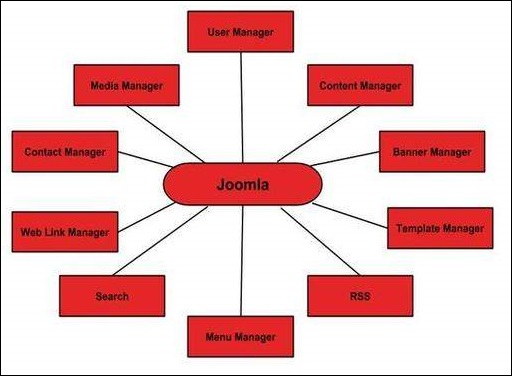Joomla is an open source
Content Management System (CMS),
which is used to build websites and online applications. It is free and
extendable which is separated into front-end and back-end templates
(administrator). Joomla is developed using PHP, Object Oriented
Programming, software design patterns and MySQL (used for storing the
data).
What is Content Management System (CMS)?
The
Content Management System (CMS) is a software which keeps
track of the entire data (such as text, photos, music, document, etc.)
which will be available on your website. It helps in editing, publishing
and modifying the content of the website.
History
Joomla is based on
Mambo CMS which was developed by an Australian company in 2001 and initially released on
August 17, 2005. The official version of Joomla 1.0 was released on
September 22, 2005.
Features
Joomla has its own powerful built-in features (core features).

- User Manager − It allows managing the user information
such as permission to edit, access, publish, create or delete the user,
change the password and languages. The main part of the user manager is Authentication.
- Content Manager − It allows managing the content using WYSIWYG editor to create or edit the content in a very simple way.
- Banner Manager − It is used to add or edit the banners on the website.
- Template Manager − It manages the designs that are used on
the website. The templates can be implemented without changing the
content structure within a few seconds.
- Media Manager − It is the tool for managing the media
files and folder in which you can easily upload, organize and manage
your media files into your article editor tool.
- Contact Manager − It allows to add contacts, managing the contact information of the particular users.
- Web Link Manager − The link resource is provided for user of the site and can be sorted into categories.
- Search − It allows users to search the appropriate
information on the site. You can use smart indexing, advanced search
options, auto suggest searches to make Joomla search best.
- Menu Manager − It allows to create menus and menu items
and can be managed subsequently. You can put menu in any style and in
multiple places.
- RSS − It stands for Really Simple syndication which helps your site contents and RSS files to be automatically updated.
Advantages
- It is an open source platform and available for free.
- Joomla is designed to be easy to install and set up even if you're not an advanced user.
- Since Joomla is so easy to use, as a web designer or developer,
you can quickly build sites for your clients. With minimal instructions
to the clients, clients can easily manage their sites on their own.
- It is very easy to edit the content as it uses WYSIWYG editor (What You See Is What You Get is a user interface that allows the user to directly manipulate the layout of the document without having a layout command).
- It ensures the safety of data content and doesn't allow anyone to edit the data.
- By default, Joomla is compatible with all browsers.
- The templates are very flexible to use.
- Media files can be uploaded easily in the article editor tool.
- Provides easy menu creation tool.
Disadvantages
- It gives compatibility problem while installing several modules, extensions and plugins simultaneously.
- Plugins and modules are not free in Joomla.
- Development is too difficult to handle when you want to change the layout.
- Joomla is not much SEO (Search Engine Optimization) friendly.
- It makes website heavy to load and run.
Real World Examples of What Joomla Can Create?
- Corporate web sites or portals
- Corporate intranets and extranets
- Online magazines, newspapers, and publications
- E-commerce and online reservations
- Government applications
- Small business web sites
- Non-profit and organizational web sites
- Community-based portals
- School and religious web sites
- Personal or family homepages



Post a Comment